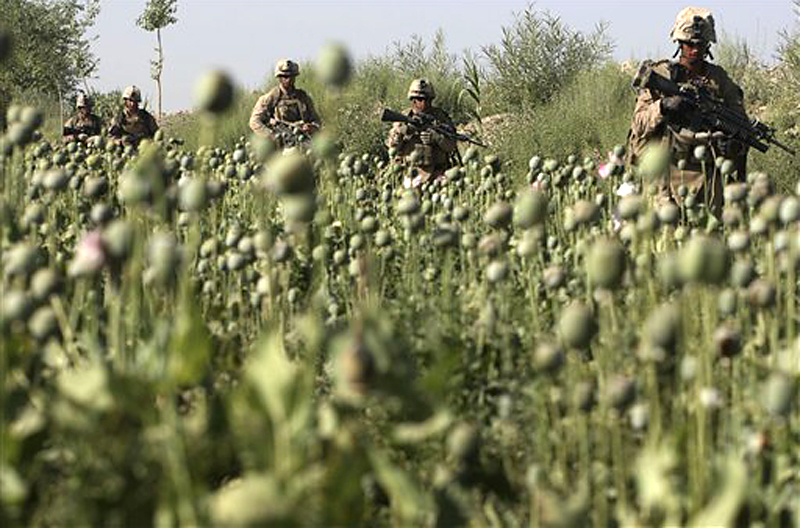Archive for November 5th, 2010
9 Reasons Why “Quantitative Easing” (QE2) Is Bad For US Economy
November 5, 2010: The Economic Collapse Editors / The Economic Collapse – November 4, 2010

Buckle up and hold on America – a new round of quantitative easing is here and things could start getting very ugly in the financial world over the coming months.
The truth is that many economists fear that an out of control Federal Reserve is “crossing the Rubicon” by announcing another wave of quantitative easing. Have we now reached a point where the Federal Reserve is simply going to fire up the printing presses and shower massive wads of cash into the financial system whenever the U.S. economy is not growing fast enough? If so, what does that mean for inflation, the stability of the world financial system and the future of the U.S. dollar?
The Fed says that the plan is to purchase $600 billion of U.S. Treasury securities by the middle of 2011. In addition, the Federal Reserve has announced that it will be “reinvesting” an additional $250 billion to $300 billion from the proceeds of its mortgage portfolio in U.S. Treasury securities over the same time period. So that is a total injection of about $900 billion. Perhaps the Fed thought that number would sound a little less ominous than $1 trillion. In any event, the Federal Reserve seems convinced that quantitative easing is going to work this time. So should we believe the Federal Reserve?
The truth is that the Federal Reserve has tried this before. In November 2008, the Federal Reserve announced a $600 billion quantitative easing program. Four months later the Fed felt that even more cash was necessary, so they upped the total to $1.8 trillion. So did quantitative easing work then?
No, not really. It may have helped stabilize the economy in the short-term, but unemployment is still staggeringly high. Monthly U.S. home sales continue to come in at close to record low levels. Businesses are borrowing less money. Individuals are borrowing less money. Stores are closing left and right.
The Fed is desperate to crank the debt spiral that our economic system is now based upon back up again. The Fed thinks that somehow if it can just pump enough nearly free liquidity into the banking system, the banks will turn around and lend it out at a markup and that this will get the debt spiral cranking again.
The sad truth is that the Federal Reserve is not trying to build an economic recovery on solid financial principles. Rather, what the Federal Reserve envisions is an “economic recovery” based on new debt creation. So will $900 billion be enough to get the debt spiral cranked up again? No.
If $1.8 trillion dollars didn’t work before, why does the Federal Reserve think that $900 billion dollars is going to work now? This new round of quantitative easing will create more inflation and will cause speculative asset bubbles, but it is not going to fix what is wrong with the economy. The damage is just too vast, as Charles Hugh Smith recently explained…
“Anyone who believes a meager one or two trillion dollars in pump-priming can overcome $15-$20 trillion in overpriced assets and $10 trillion in uncollectible debt may well be disappointed.”
In fact, economists over at Goldman Sachs estimate that it would take a staggering $4 trillion in quantitative easing to get the economy rolling again. Of course that may eventually be what happens. The Fed may be starting at $900 billion just to get the door open. With these kinds of bureaucrats, once you give them an inch they usually end up taking a mile.
So why should we be concerned about quantitative easing? The following are 9 reasons why quantitative easing is bad for the U.S. economy…
#1: Quantitative Easing Will Damage The Value Of The U.S. Dollar
Each time you add a new dollar to the system, it decreases the value of each existing dollar by just a little bit. Now the Federal Reserve is pumping $900 billion dollars into the system and that is going to have a significant impact. Bill Gross, the manager of the largest mutual fund in the entire world, said on Monday that he believes that more quantitative easing could result in a decline of the U.S. dollar of up to 20 percent… “I think a 20 percent decline in the dollar is possible.”
#2: Inflation Is Going To Hit Already Struggling U.S. Consumers Really Hard
Already, investors have been fleeing from the U.S. dollar and other paper currencies and have been flocking to commodities, precious metals and oil. That means that the price of food is going to go up. The price of gasoline is also going to go up. American families are going to find their budgets stretched even more in the months ahead.
#3: Once An Inflationary Spiral Gets Going It Is Really Hard To Stop
The Federal Reserve is playing a very dangerous game by flirting with inflation. Once an inflationary spiral gets going, it is really difficult to stop. Just ask anyone who lived through the Weimar Republic or anyone who lives in Zimbabwe today. If the Federal Reserve is now going to be dumping hundreds of billions of fresh dollars into the system whenever the economy gets into trouble, it is inevitable that we will see rampant inflation at some point.
#4: Inflation Is A Hidden Tax On Every American
Tens of millions of Americans have worked incredibly hard to save up a little bit of money. These Americans are counting on that money to pay for a home, or to pay for retirement or to pay for the education of their children. Well, inflation is like a hidden tax on all of those savings. In fact, inflation is a hidden tax on every single dollar that all of us own. We have been taxed more than enough – we certainly don’t need the Federal Reserve imposing another hidden tax on all of us.
#5: The Solution To The Housing Bubble Is Not Another Housing Bubble
Today, approximately a third of all U.S. real estate is estimated to have negative equity. The Federal Reserve apparently believes that by flooding the system with gigantic sacks of cash, banks will start making home loans like crazy again and home prices will rise substantially once again – thus wiping out most of that negative equity.
But the solution to the housing bubble is not another housing bubble. The kinds of crazy home loans that were made back in the middle of the decade should never be made again. Market forces should be allowed to bring the housing market to a new equilibrium where ordinary Americans can actually afford to purchase homes. But that is not how our system works anymore. Today, everything has to be manipulated.
#6: More Quantitative Easing Threatens To Destabilize The Global Financial System
We have already entered a time of increasing global financial instability, and the Federal Reserve is not going to help things by introducing hundreds of billions of new dollars into the game. Over the past two decades, bubble after bubble has caused tremendous economic problems, and now all of this new money could give rise to new bubbles. Already, we see financial institutions and investors pumping up carry trade bubbles, engaging in currency speculation and driving up commodity prices to ridiculous levels.
#7: Quantitative Easing Is An Aggressive Move In A World Already On The Verge Of A Currency War
Quantitative easing will likely help U.S. exporters by causing the value of the U.S. dollar to sink. However, this gain by U.S. exporters will come at the expense of foreigners. It is essentially a “zero sum” game. So all of those exporting countries that are already upset with us will become even more furious as the U.S. dollar declines. Could we witness the first all-out “global currency war” in 2011?
#8: Quantitative Easing Threatens The Status Of The Dollar As The World Reserve Currency
As the Federal Reserve continues to play games with the U.S. dollar, quite a few nations around the globe will start evaluating whether or not they want to continue to trade with the U.S. dollar and use it as a reserve currency. In fact, a recent article on The Market Oracle website explained how this is already happening…
“In September, China supported a Russian proposal to start direct trading using the yuan and the ruble rather than pricing their trade or taking payment in U.S. dollars or other foreign currencies. China then negotiated a similar deal with Brazil. And on the eve of the IMF meetings in Washington on Friday, Premier Wen stopped off in Istanbul to reach agreement with Turkish Prime Minister Erdogan to use their own currencies in a planned tripling Turkish-Chinese trade to $50 billion over the next five years, effectively excluding the dollar.”
#9: It Is Going To Become More Expensive For The U.S. Government To Borrow Money
Right now, the U.S. government has been able to borrow money at ridiculously low interest rates. But as the Federal Reserve keeps buying up hundreds of billions in U.S. Treasuries, the rest of the world is going to start refusing to participate in the ongoing Ponzi scheme. Peter Schiff, the CEO of Euro Pacific Capital, says that one of the big reasons for more quantitative easing is because the U.S. government is already starting to have difficulty finding enough people to borrow from…
“At the end of the day, all this deflation talk is a red herring. The true purpose of QE 2 is to disguise the decreasing ability of the Treasury to finance its debts. As global demand for dollar-denominated debt falls, the Fed is looking for an excuse to pick up the slack. By announcing QE2, it can monetize government debt without the markets perceiving a funding problem.”
But the truth is that foreigners are not stupid. They can see the shell game that is being played. As Bill Gross noted on Monday, U.S. government debt will soon become a lot less attractive to foreign investors…
“QE2 not only produces more dollars but it also lowers the yield that investors earn on them and makes foreigners, which is the key link to the currencies, it makes foreigners less willing to hold dollars in current form or at current prices.”
As foreigners begin to balk at all of this nonsense, the U.S. government will either have to start paying higher interest rates on government debt in order to attract enough investors, or the Federal Reserve will just have to drop all pretense and permanently start buying up most of the debt. Either way, once faith has been lost in U.S. Treasuries the financial world will never, ever be the same.
Most Americans have absolutely no idea how fragile the world financial system is right now. Once the rest of the world loses faith in the U.S. dollar and in U.S. Treasuries this entire thing could completely unravel very quickly. The Federal Reserve is playing a very dangerous game. They are openly threatening the delicate balance of the world financial system. Once the toothpaste is out of the tube, it is really hard to put it back in again. Cross your fingers and hold on tight, because things are going to get really bumpy ahead.
TTR: The following documentary won the 2010 Beloit International Film Festival for Best Documentary, as well as the 2009 Silver Sierra Award at the Yosemite Film Festival. This is an absolutely outstanding film! – SJH
The Secret Of Oz: Full Length Version
The Tonka Report Editor’s Note: This is all being done by design to eviscerate the Middle Class, and thus saddle the American people with insurmountable debt in order to collapse the United States of America into a fascist dictatorship controlled by the occult Zionist international banksters and eugenicist globalists… – SJH
Link to original article below…
Written by Steven John Hibbs
November 5, 2010 at 1:44 pm
Posted in Big Ag, Big Brother, Big Oil, Civil Rights, Communism, Conspiracy, Corruption, Deception, Disinformation, Documentary, Economy, Education, Fascism, Federal Reserve, Freedom, Geo-Politics, Global Banking, Government, History, IMF, Law and Justice, New World Order, Obama, Obama Regime, Orwellian, Propaganda, Psyops, Slavery, Socialism, Sovereignty, U.S. Constitution, U.S. News, Video, World Bank, World Disasters, World Government, World News, Zionism
Dollar Begins Crash In Response To QE2 As Gold Scores New High
November 5, 2010: Kurt Nimmo / Prison Planet.com – November 5, 2010

Earlier this year, Lindsey Williams told Alex Jones the globalists would devalue the dollar and jack up the price of oil. Both are now happening.
On Thursday, in response to the Federal Reserve’s announcement that it plans to monetize the debt and increase the money supply, economists and market strategists warned that the sickly U.S. dollar is now at risk of crashing and consumers will soon be hammered with higher prices.
“Consumers should prepare for another turn of events like the spring of 2008, when oil prices soared to $147 a barrel and gas at the pump was more than $4 a gallon,” Axel Merk, chairman and chief investment officer of Merk Investments, of Portland, Maine, told CNBC.
Oil futures reached $87.22, the highest price in more than two years, Bloomberg reports this morning. Merk said the Fed’s plan for inflation will show up at the gas pump. “We’re not going to get wages to go up. We’ll get the price at the gas pump to go up instead,” he said.
The Fed’s Q2E plan is being roundly condemned. China, Germany and Brazil are warning that the plan to inject more than $600 billion of funny money created out of thin air into the economy will have disastrous consequences. It will send money flooding into their markets seeking higher returns and that will drive up exchange rates and hamper exports by making their goods more expensive.
China’s central bankers are not ebullient. “If the domestic policy is optimal policy for the United States alone, but at the same time it is not an optimal policy for the world, it may bring a lot of negative impact to the world. There is a spillover,” said Zhou Xiaochuan, governor of the People’s Bank of China.
Investors are scampering in search of shelter. “There’s no such thing anymore as a safe asset. Cash is no longer safe,” said Merk. “Do what central banks do, they diversify to baskets of currencies.” Gold, silver, and precious metals remain a strong diversification option.
On Friday, gold futures shot up higher and posted a new record, their second in a row and a day after the metal had its biggest one-day gain in nearly 20 months. Gold rallied to $1,383.10 an ounce on Thursday after the Federal Reserve announced its policy to attack the dollar and unleash a broadside on the world economy through its QE2.
Bernanke Lies Under Oath About Monetizing The Debt
The Tonka Report Editor’s Note: Brace yourselves for one helluva rough ride ahead, America! – SJH
Link to original article below…
http://www.prisonplanet.com/dollar-begins-crash-in-response-to-qe2-as-gold-scores-new-high.html
Written by Steven John Hibbs
November 5, 2010 at 12:27 pm
Posted in Big Ag, Big Brother, Big Oil, Civil Rights, Communism, Conspiracy, Corruption, Deception, Disinformation, Economy, Education, Fascism, Federal Reserve, Freedom, Geo-Politics, Global Banking, Government, History, Law and Justice, New World Order, Obama, Obama Regime, Orwellian, Propaganda, Psyops, Slavery, Socialism, Sovereignty, U.S. Constitution, U.S. News, Video, World Bank, World Disasters, World Government, World News
Rumors Swirl Of Possible Bank Holiday Amidst US Currency Crisis!
November 5, 2010: Paul Joseph Watson / Prison Planet.com – November 5, 2010

With the world on the verge of a currency war as the Federal Reserve follows through on its dollar-killing quantitative easing program, rumors are once again swirling of a “bank holiday,” during which US citizens will be prevented from withdrawing money or at least limited in the amount of the withdrawal they can make.
The bank holiday is rumored to be set for next week, with Thursday November 11 pinpointed as the likeliest date.
According to radio host Steve Quayle, a pastor was told by one of the managers of a prominent east coast bank that banks would close for an undetermined amount of time, and that when they reopened, “all withdrawals by checks would be limited to $500 per week – no matter what the balance in the account is.”
Limiting the amount of money customers can withdraw or blocking the facility altogether reminds us of a Citigroup advisory that was sent to customers at the start of the year which stated that the bank reserved “the right to require (7) days advance notice before permitting a withdrawal from all checking accounts.” The story stoked fears that financial institutuions were preparing for bank runs.
On his website, Quayle asks, “When in U.S. History has a sitting President taken off on an overseas trip for an extended period of time, with 65 airplanes, 34 warships reportedly 3,000 people including his friends and cohorts, at the pinnacle of an economic and political upheaval?”
Fears of a bank holiday first arose in June of last year, when it was rumored that banks would close their doors in early September. Concern was fueled by reports that US embassies in foreign countries were purchasing large quantities of local currency.
With Brazil and other countries now threatening to take drastic currency measures to protect themselves against a dollar crisis, a similar financial environment is stoking identical fears.
Bank holidays are not without precedent in the United States. On March 5 1933, newly elected Franklin Roosevelt declared a “bank holiday” that lasted four days, during which he rammed through the Emergency Banking Act which granted FDR near dictatorial control over the dealings of banks. The Act also forced every citizen and business in the country to relinquish their gold in exchange for paper currency.
The 1933 bank holiday served as a face-saving mechanism for many financial institutions – thousands of them never reopened after the closure period had ended.
While we expect it to be business as usual next week and the rumors to subside as they did last year, the mere fact that this fear keeps cropping up shows how jittery the economic landscape is right now.
Indeed, the debate is no longer about whether the US financial system and the dollar will come crashing down or not, but if that inevitable process will be characterized as a sudden collapse or death by a thousand cuts. The latter seems to be more likely, with a few lurches and leaps along the way, the first of which was Ben Bernanke’s announcement on Tuesday that the Fed will buy $600 billion of U.S. government bonds over the next eight months.
The blame for this turmoil can be laid firmly at the feet of Bernanke, acting at the behest of the Fed’s owners, who having promised in June last year that they would not monetize the debt of the U.S. government. have now embarked upon a “mad experiment” that will precipitate “the collapse of the US dollar paper standard,” as CLSA’s Chris Wood describes it.
As the Honorable Louis McFadden, Chairman of the House Banking and Currency Committee, warned in 1933, the Fed does not care that it is killing the dollar because its role is to represent the interests of its international owners and its Wall Street cronies, not the American people.
“Some people think that the Federal Reserve Banks are United States Government institutions. They are private monopolies which prey upon the people of these United States for the benefit of themselves and their foreign customers; foreign and domestic speculators and swindlers; and rich and predatory money lenders,” said McFadden.
So while the happy clappers on Wall Street are drunkenly celebrating the fact that their artificially inflated stock market is surging solely as a result of the value of the dollar being eviscerated, Main Street is hunkering down for a long winter, beset by worries about hyperinflation, rising food prices and gas price hikes, as oil follows gold’s meteoric rise, again solely as a result of the Fed’s decision to debase the greenback.
Financial upheaval has been matched by political upheaval, and we can only hope that Congressman Ron Paul and his son, Senator in waiting Rand Paul, can build momentum to finally cut out the cancer that is destroying America – by ending the Fed for good.
The Tonka Report Editor’s Note: The banksters could be testing the waters by putting this information out there, if indeed it’s true, to see how Americans react to it. And then again, with all indications now pointing to a possible false flag terrorist attack in the near future, this would indicate those fears to be legitimate… – SJH
Link to original article below…
http://www.prisonplanet.com/bank-holiday-rumors-swirl-amidst-currency-crisis.html
Written by Steven John Hibbs
November 5, 2010 at 11:44 am
Posted in Big Brother, Civil Rights, Communism, Conspiracy, Corruption, Deception, Disinformation, Economy, Education, Fascism, Federal Reserve, Freedom, Geo-Politics, Global Banking, Government, History, Law and Justice, Martial Law, New World Order, Obama, Obama Regime, Orwellian, Police State, Propaganda, Psyops, Slavery, Socialism, Sovereignty, U.S. Constitution, U.S. News, Video, World Bank, World Disasters, World Government, World News
























